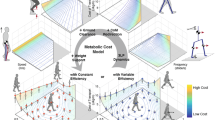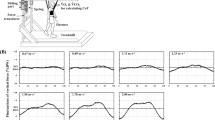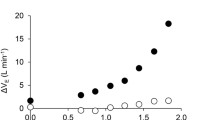Abstract
It is well established that the energy cost per unit distance traveled is minimal at an intermediate walking speed in humans, defining an energetically optimal walking speed. However, little is known about the optimal walking speed while carrying a load. In this work, we studied the effect of speed and load on the energy expenditure of walking. The O2 consumption and CO2 production were measured in ten subjects while standing or walking at different speeds from 0.5 to 1.7 m s−1 with loads from 0 to 75% of their body mass (Mb). The loads were carried in typical trekker’s backpacks with hip support. Our results show that the mass-specific gross metabolic power increases curvilinearly with speed and is directly proportional to the load at any speed. For all loading conditions, the gross metabolic energy cost (J kg−1 m−1) presents a U-shaped curve with a minimum at around 1.3 m s−1. At that optimal speed, a load up to 1/4 Mb seems appropriate for long-distance walks. In addition, the optimal speed for net cost minimization is around 1.06 m s−1 and is independent of load.





Similar content being viewed by others
References
Abe D, Yanagawa K, Niihata S (2004) Effects of load carriage, load position, and walking speed on energy cost of walking. Appl Ergon 35:329–335
Ardigo LP, Saibene F, Minetti AE (2003) The optimal locomotion on gradients: walking, running or cycling? Eur J Appl Physiol 90:365–71
Astrand PO, Rodhal K (1977) Textbook of work physiology. McGraw Hill, New York
Balogun JA (1986) Ergonomic comparison of three modes of load carriage. Int Arch Occup Environ Health 58:35–46
Bobbert AC (1960) Energy expenditure in level and graded walking. J Appl Physiol 15:1015–1021
Cathcart EP, Richardson DT, Campbell W (1923) On the maximum load to be carried by the soldier. J R Army Med Corps 40:435–443; 41:12–24; 41:87–98; 41:161–178
Cavagna GA, Thys H, Zamboni A (1976) The sources of external work in level walking and running. J Physiol (Lond) 262:639–657
Cotes JE, Meade F (1960) The energy expenditure and mechanical energy demand in walking. Ergonomics 3:96–119
Cymerman A, Pandolf KB, Young AJ, Maher JT (1981) Energy expenditure during load carriage at high altitude. J Appl Physiol 51:14–18
Das SK, Saha H (1966) Climbing efficiency with different modes of load carriage. Indian J Med Res 54:866–871
Datta SR, Ramanathan NL (1971) Ergonomic comparison of seven modes of carrying loads on the horizontal plane. Ergonomics 14:269–278
DeJaeger D, Willems PA, Heglund NC (2001) The energy cost of walking in children. Pflügers Arch 441:538–543
Epstein Y, Rosenblum J, Burstein R, Sawka MN (1988) External load can alter the energy cost of prolonged exercise. Eur J Appl Physiol Occup Physiol 57:243–247
Evans WJ, Winsmann FR, Pandolf KB, Goldman RF (1980) Self-paced hard work comparing men and women. Ergonomics 23:613–621
Falola JM, Delpech N, Brisswalter J (2000) Optimization characteristics of walking with and without a load on the trunk of the body. Percept Mot Skills 91:261–272
Givoni B, Goldman RF (1971) Predicting metabolic energy cost. J Appl Physiol 30:429–433
Goldman RF, Iampietro PF (1962) Energy cost of load carriage. J Appl Physiol 17:675–676
Gordon MJ, Goslin BR, Graham T, Hoare J (1983) Comparison between load carriage and grade walking on a treadmill. Ergonomics 26:289–298
Griffin TM, Roberts TJ, Kram R (2003) Metabolic cost of generating muscular force in human walking: insights from load-carrying and speed experiments. J Appl Physiol 95:172–183
Hausswirth C, Bigard AX, Lechevelier JM (1997) The Cosmed K4 telemetry system as an accurate device for oxygen uptake measurement during exercise. Int J Sports Med 18:449–453
Heglund NC, Willems PA, Penta M, Cavagna GA (1995) Energy-saving gait mechanics with head-supported loads. Nature 375:52–54
Holewijn M (1990) Physiological strain due to load carrying. Eur J Appl Physiol Occup Physiol 61:237–245
Hughes AL, Goldman RF (1970) Energy cost of “hard work”. J Appl Physiol 29:570–572
Kram R (1991) Carrying loads with springy poles. J Appl Physiol 71:1119–1122
Legg SJ (1985) Comparison of different methods of load carriage. Ergonomics 28:197–212
Legg SJ, Mahanty A (1985) Comparison of five modes of carrying a load close to the trunk. Ergonomics 28:1653–1660
Legg SJ, Ramsey T, Knowles DJ (1992) The metabolic cost of backpack and shoulder load carriage. Ergonomics 35:1063–1068
Levine L, Evans WJ, Winsmann FR, Pandolf KB (1982) Prolonged self-paced hard physical exercise comparing trained and untrained men. Ergonomics 25:393–400
Lloyd R, Cooke CB (2000) The oxygen consumption associated with unloaded walking and load carriage using two different backpack designs. Eur J Appl Physiol 81:486–492
Maloiy GMO, Heglund NC, Prager LM, Cavagna GA, Taylor CR (1986) The energetic cost of carrying loads: have African women discovered an economic way? Nature 319:668–669
Margaria R (1938) Sulla fisiologia e specialmente sul consumo energetico della marcia e della corsa a varia velocita ed inclinazione del terreno. Atti Acc Naz Lincei 7:299–368
Minetti AE, Boldrini L, Brusamolin L, Zamparo P, McKee T (2003) A feedback-controlled treadmill (treadmill-on-demand) and the spontaneous speed of walking and running in humans. J Appl Physiol 95:838–843
Myles WS, Saunders PL (1979) The physiological cost of carrying light and heavy loads. Eur J Appl Physiol Occup Physiol 42:125–131
Myles WS, Eclache JP, Beaury J (1979) Self-pacing during sustained, repetitive exercise. Aviat Space Environ Med 50:921–924
Nag PK, Sen RN, Ray US (1978) Optimal rate of work for mountaineers. J Appl Physiol 44:952–955
Pandolf KB, Givoni B, Goldman RF (1977) Predicting energy expenditure with loads while standing or walking very slowly. J Appl Physiol 43:577–581
Passmore R, Durnin JV (1955) Human energy expenditure. Physiol Rev 35:801–840
Pierrynowski MR, Winter DA, Norman RW (1981) Metabolic measures to ascertain the optimal load to be carried by man. Ergonomics 24:393–399
Pimental NA, Pandolf KB (1979) Energy expenditure while standing or walking slowly uphill or downhill with loads. Ergonomics 22:963–973
di Prampero PE (1986) The energy cost of human locomotion on land and in water. Int J Sports Med 7:55–72
Ralston HJ (1958) Energy-speed relation and optimal speed during level walking. Int Z Angew Physiol 17:277–283
Saha PN, Datta SR, Banerjee PK, Narayane GG (1979) An acceptable workload for Indian workers. Ergonomics 22:1059–1071
Samanta A, Datta SR, Roy BN, Chatterjee A, Mukherjee PK (1987) Estimation of maximum permissible loads to be carried by Indians of different ages. Ergonomics 30:825–831
Schmidt RF, Thews G (1983) Human physiology. Springer, Berlin Heidelberg New York
Soule RG, Goldman RF (1969) Energy cost of loads carried on the head, hands, or feet. J Appl Physiol 27:687–690
Soule RG, Pandolf KB, Goldman RF (1978) Energy expenditure of heavy load carriage. Ergonomics 21:373–381
Wickler SJ, Hoyt DF, Cogger EA, Hall KM (2001) Effect of load on preferred speed and cost of transport. J Appl Physiol 90:1548–1551
Willems PA, Cavagna GA, Heglund NC (1995) External, internal and total work in human locomotion. J Exp Biol 198:379–393
Wilmore JH, Costill DL (1994) Physiology of sport and exercise. Human Kinetics, Champaign, Ill.
Workman JM, Armstrong BW (1963) Oxygen cost of treadmill walking. J Appl Physiol 18:798–803
Workman JM, Armstrong BW (1986) Metabolic cost of walking: equation and model. J Appl Physiol 61:1369–1374
Zarrugh MY, Radcliffe CW (1978) Predicting metabolic cost of level walking. Eur J Appl Physiol Occup Physiol 38:215–223
Zarrugh MY, Todd FN, Ralston HJ (1974) Optimization of energy expenditure during level walking. Eur J Appl Physiol Occup Physiol 33:293–306
Acknowledgements
This study was supported by the National Geographic Society, the Fonds National de la Recherche Scientifique of Belgium, and the Fonds Spécial de la Recherche of UCL.
Author information
Authors and Affiliations
Corresponding author
Rights and permissions
About this article
Cite this article
Bastien, G.J., Willems, P.A., Schepens, B. et al. Effect of load and speed on the energetic cost of human walking. Eur J Appl Physiol 94, 76–83 (2005). https://doi.org/10.1007/s00421-004-1286-z
Accepted:
Published:
Issue Date:
DOI: https://doi.org/10.1007/s00421-004-1286-z




